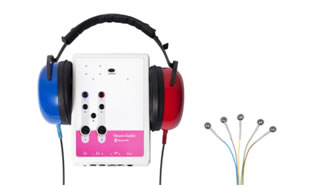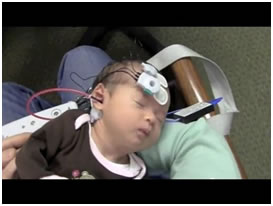Official Journals By StatPerson Publication
|
Table of Content - Volume 9 Issue 1 - January 2019
Ganesh M Kale1, Gopal Jaiwal2*
1Professor and HOD, Department of ENT, Dr. Panjabrao Deshmukh Memorial Medical College , Amravati, Maharashtra, INDIA. 2Consultant Audiologist and Speech Pathologist, Amravati, Maharashtra, INDIA. Email: gopaljaiwal176@gmail.com
Abstract Purpose: To describe the electrophysiological (ABR) findings in a group of children with Autism Spectrum Disorder with Normal Children. Method: a group of 15 children with autistic disorder and 15 normal children were included in an investigation of auditory brain stem response ABR Result: the children who were diagnosed with ASD found with significantly delayed or prolonged latencies of ABR wave V and inter peak latencies I-V in ABR as compared to the normal children. Conclusion: Possible causes of the reported ABR abnormalities, observed here as well as in other studies, are discussed. Brain stem lesion, occult cochlear dysfunction, and involvement of the cochlear efferent system are probable factors that can explain the ABR findings. Thus comprehension of the potentially a typical auditory processing in the children with ASD may be key to analysed different causes of Autism. Key Word: ABR.
INTRODUCTION What is autism? Autism is a complex neurobehavioral condition that includes impairments in social interaction and developmental language and communication skills combined with rigid, repetitive behaviours. B of the range of symptoms, this condition is now called autism spectrum disorder (ASD). It covers a large spectrum of symptoms, skills, and levels of impairment. ASD ranges in severity from a handicap that somewhat limits an otherwise normal life to a devastating disability that may require institutional care. Children with autism have trouble communicating. They have trouble understanding what other people think and feel. This makes it very hard for them to express themselves either with words or through gestures, facial expressions, and touch A child with ASD who is very sensitive may be greatly troubled sometimes even pained by sounds, touches, smells, or sights that seem normal to others. Children who are autistic may have repetitive, stereotyped body movements such as rocking, pacing, or hand flapping. They may have unusual responses to people, attachments to objects, resistance to change in their routines, or aggressive or self-injurious behavior. At times they may seem not to notice people, objects, or activities in their surroundings. Some children with autism may also develop seizures. And in some cases, those seizures may not occur until adolescence. Some people with autism are cognitively impaired to a degree. In contrast to more typical cognitive impairment, which is characterized by relatively even delays in all areas of development, people with autism show uneven skill development. They may have problems in certain areas, especially the ability to communicate and relate to others. But they may have unusually developed skills in other areas, such as drawing, creating music, solving math problems, or memorizing facts. For this reason, they may test higher -- perhaps even in the average or above-average range -- on nonverbal intelligence tests. Symptoms of autism typically appears during the first three years of life. Some children show signs from birth. Others seem to develop normally at first, only to slip suddenly into symptoms when they are 18 to 36 months old. However, it is now recognized that some individuals may not show symptoms of a communication disorder until demands of the environment exceed their capabilities. Autism is four times more common in boys than in girls. It knows no racial, Autism is just one syndrome that now falls under the heading of autism spectrum disorders. Previous disorders that are now classified under the umbrella diagnosis of ASD or a social communication disorder include: Autistic disorder. This is what most people think of when they hear the word "autism." It refers to problems with social interactions, communication, and imaginative play in children younger than 3 years. Asperger's syndrome. These children don't have a problem with language -- in fact, they tend to score in the average or above-average range on intelligence tests. But they have the same social problems and limited scope of interests as children with autistic disorder. Pervasive developmental disorder or PDD -- also known as atypical autism. This is a kind of catch-all category for children who have some autistic behaviors but who don't fit into other categories. Childhood disintegrative disorder. These children develop normally for at least two years and then lose some or most of their communication and social skills. This is an extremely rare disorder and its existence as a separate condition is a matter of debate among many mental health professionals. Rett syndrome previously fell under ASD spectrum but it is now confirmed that Rett’s cause is genetic. It no longer falls under ASD guidelines. Children with Rett syndrome, primarily girls, start developing normally but then begin losing their communication and social skills. Beginning at the age of 1 to 4 years, repetitive hand movements replace purposeful use of the hands. Children with Rett syndrome are usually severely cognitively impaired. Family income, ethnic, social boundaries, lifestyle, or educational levels do not affect a child's chance of being autistic. However a definitive diagnosis of autism is often not made until the age of 4 to 4 ½ yrs as result of overlapping condition and scant information on behavioural characteristics at younger ages. The differential diagnosis and appropriate intervention of the population are conducted using subjective and objective procedure. i.e., depends on the subjects responses it may be impaired due to interaction problems of this population, which may generate unreliable responses. In order to reduce this variability electrophysiological (ABR) measures in assessment of children with ASD provide an accurate diagnosis and more effective intervention. The goal of the present study was to compare the ABRs of young children with suspected ASDs with an age-matched control group Auditory Evoked Potentials (Aep) An auditory evoked responses (AER) is the activity (a “response”) within the auditory system (the ear, the auditory nerve, auditory regions of the brain) that is produced or stimulated or “evoked“ by sounds (auditory or acoustic stimuli ) hall et.al. AEP compromise a continuum of neuroelectric events that are generated along the entire length of the auditory pathway. In general auditory evoked responses are brain waves (electric potentials) generated when a person is stimulated with sounds. This electrical activity is picked up by the electrodes, which are usually placed at specific places on the scalp and near the ear (mastoid or earlobes). Under conventional recording conditions, as many as 15 AEP’s have been identified within the first 500ms post stimulus onset (Picton, Hillyard, krauzandgalambos, 1974; Picton, Woods Baribeau-Braun, and Healey, 1977). The underlying physiological principle is that evoked potentials may be measured independently ABR The ABR is without a doubt is the most commonly used AEP for clinical purpose mainly it has been used extensively as a non – invasive electrophysiological tool for the study of human auditory system (R. Bukatd, (1993)) The ABR is the time locked response from the first description of the human ABR, independently by jewtt and Williston (1971) and Lev and sohmer (1972). the responses has been described by variety of term and acronyms (Hall (1993) Figure 1: Neurosoft ABR instrument
The term ABR was formally introduced by Davis (1979) in a report of US japan seminar on “Auditory Response from Brainstem “The ABR is a series of vertex positive waves that occurs within 15ms of the onset of the click or other stimuli in humans. These peaks are typically labelled by Jewett and Williston convention using sequential capital roman numerals. Although seven peaks are often seen in most common instance only waves I-V are evaluated clinically. As waves II and IV are quiet variable in amplitude and identifiability, the most commonly evaluated peaks include I, III and V. Further the ABR can be obtained in human’s foetuses as early as by the end of second trimester. The ABR is strongly dependent on a wide range of stimulus manipulations. Finally ABR is affected in characteristics ways by disorders of the ear and brainstem(R.Bukard,1993). These peaks are generated at different sites in the auditory system. Recording: The function of all instrumentation is to record EP’s and simply to improve the signal to noise ratio of the electrophysiological test. This is achieved in several ways. Electrodes techniques and placements, differential amplification, filtering and time domain averaging, contribute to final improvement in SNR and each is considered separately. Figure 2: Electrode and ear phone placement for ABR in children
Electrodes The electrical fields generated from caudal regions of the auditory mechanism are transmitted within a volume conductive medium of extracellular fluid and tissue. Thus, any electrodes located on the scalp and remote from generated electrical field will potential register neural activity causing the label reference(suggesting a non active or indifferent electrical site) to be inaccurate. Two sets of alternative electrode terms have gained clinical acceptance. They are positive and negative related to electrode input at the preamplifier stage and inverting and non inverting describing amplifier function. The third electrode is the ground or the common electrode. These electrodes are placed at the mastoid or forehead. Different parameters required by diagnostic application of threshold estimation have been stresses. To summarize the parameters, an ABR used with Click stimuli will be considered. The band pass filter settings are generally 100to 3000 Hz with a low intensity rate about 10 clicks/sec. A 15 ms averaging time window is adequate. Atleast 2000 sweeps are recommended for an average with each condition being replicated at least once. Figure 3: Wave I,II,III,IV,V,VI,VII representation of AB MATERIALS AND METHODS In the experimental group we took group of thirty children .in which 15 children are normal and 15 children with autism spectrum disorders. All this children were selected from Dr. PDMC hospital and Suvarna speech and hearing clinic. Auditory brainstem evoked potential were recorded in 2 channel setup with four electrode configuration that is two electrode both side of mastoid process, one electrode on fore head as ground point and one at vertex to optimize detection of wave V, click stimuli were rarefaction clicks presented monoaurally at rates of 21.1 and at intensities from 25 dBnhl to 80dBnhl. Different averages were documented for wave interpretation throughout testing electrode generated impedance value and artefact rate were eventually monitored to maintain test retest reliability latency intensity function test inter peak latency and wave amplitude were taken into account for better diagnosis.
RESULTS Absolute latencies and inter peak latencies of the ABR were compared between infants with autism spectrum disorder and with normal children. In comparison the children who were diagnosed with ASD were found with prolonged latencies of ABR wave V and interpeak latencies of I-V in ABR during stimulation of both ears.
CONCLUSION ABR informs us regarding the processing of a acoustic stimuli particularly in brainstem, these findings provide a clinical evidence of a brainstem abnormalities and suggest that the brainstem may be partly responsible for a deviant language, cognitive, and a social development in children with ASD as language deficit are a core feature of ASD, the study of auditory processing is essential to considering the roots of ASD as well as to conceptualize rational interventions.
REFERENCES
|
|
 Home
Home



